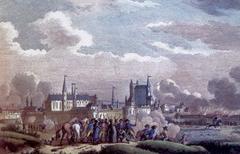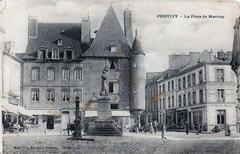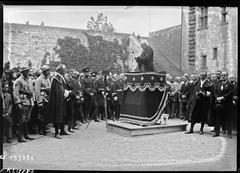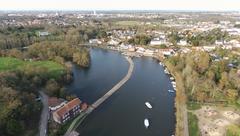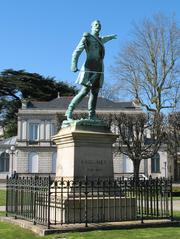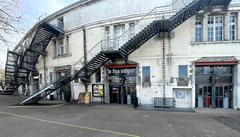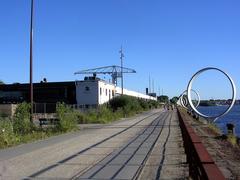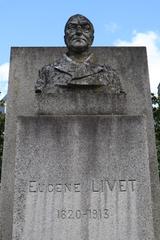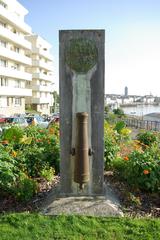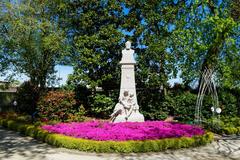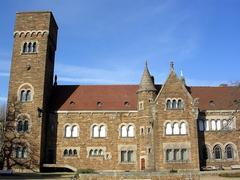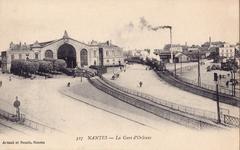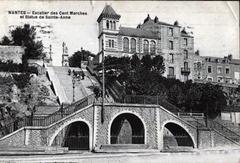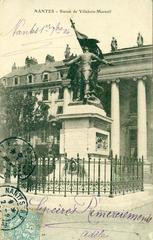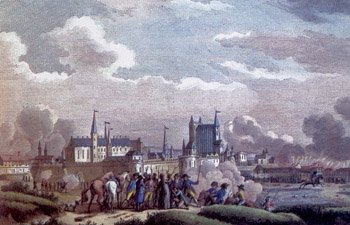
Battle of Nantes Site: Visiting Hours, Tickets, and Comprehensive Guide to Nantes’ Historical Sites
Date: 14/06/2025
Introduction: The Battle of Nantes and Its Cultural Significance
Nantes, a city on the Loire River in western France, is deeply interwoven with the narrative of the French Revolution and the War in the Vendée. The Battle of Nantes—fought on 29 June 1793—was a defining moment, underscoring the city’s strategic importance and resilience as a revolutionary stronghold. Today, Nantes invites visitors to explore this pivotal episode through meticulously preserved sites, immersive museums, and commemorative events that animate its storied past.
Exploring the legacy of the Battle of Nantes offers not just a look into the city’s military and political history, but also its cultural identity and urban development. Landmarks like the Château des Ducs de Bretagne (home to the Musée d’Histoire de Nantes), the Bouffay district, and the Memorial to the Abolition of Slavery contextualize the city’s transformation and enduring spirit. This guide provides practical information about visiting hours, tickets, accessibility, and recommended tours—ensuring your journey into Nantes’ revolutionary heritage is both enriching and seamless.
For authoritative resources and up-to-date travel details, consult Alpha History, World History Edu, and the official Nantes Tourism portal.
Contents
- Introduction & Historical Overview
- Key Historical Sites in Nantes
- Château des Ducs de Bretagne
- Cathédrale Saint-Pierre-et-Saint-Paul
- Bouffay District
- Place Royale & Place du Bouffay
- Loire River & Quai de la Fosse
- Memorials & Museums
- The Green Line Walking Trail
- Practical Visitor Information
- Visiting Hours & Tickets
- Accessibility
- Guided Tours & Special Events
- Getting There & Nearby Attractions
- Travel Tips
- FAQs
- Conclusion & Visitor Recommendations
- Sources
Historical Overview: The Battle of Nantes and the War in the Vendée
Nantes and the Vendée: Revolutionary Backdrop
During the French Revolution, Nantes became a key Republican bastion, while the neighboring Vendée region—predominantly rural and Catholic—rose in rebellion against anti-clerical reforms and conscription. The War in the Vendée, starting in 1793, saw the Catholic and Royal Army challenge Republican control, culminating in the attempt to seize Nantes (Alpha History; World History Edu).
The Battle of Nantes: June 1793
On 29 June 1793, royalist forces launched a major assault on Nantes. Despite early advances, the Republican defenders, led by General Canclaux, successfully repelled the attack. The death of Vendean leader Jacques Cathelineau and the failure to capture this strategic port marked a turning point in the conflict, preserving Republican control and stalling the royalist advance (Alpha History).
Aftermath and Legacy
In response, the Convention unleashed the “Infernal Columns,” resulting in devastating reprisals across the Vendée. Nantes remained a center of revolutionary justice and, today, commemorates its role through museums, memorials, and educational initiatives (World History Edu).
Key Historical Sites & Attractions in Nantes
Château des Ducs de Bretagne & Musée d’Histoire de Nantes
- Location: 4 Place Marc Elder, 44000 Nantes
- Significance: Central fortress during the Battle of Nantes and seat of the Dukes of Brittany. Now hosts the Musée d’Histoire de Nantes, with detailed exhibits on the revolution and the War in the Vendée (frenchmoments.eu; artdistance.com).
- Features: 500-meter wall walk, panoramic ramparts, moat, multimedia displays, and rampart views of the Loire River.
- Visiting Hours: Daily 10:00 AM–6:00 PM (extended to 7:00 PM in summer).
- Tickets: €8 (adults), discounts for youth and families, free for children under 18. Tickets available onsite or online (Nantes Tourism - Château Tickets).
- Accessibility: Wheelchair accessible with ramps and elevators.
Cathédrale Saint-Pierre-et-Saint-Paul
- Significance: Gothic cathedral with deep connections to Nantes’ revolutionary history (frenchmoments.eu; loirelovers.fr).
- Visiting Hours: Mon–Sat 8:00 AM–7:00 PM; Sun 1:00 PM–7:00 PM. Free entry.
- Accessibility: Ramps available at entrances.
Bouffay District
- Highlights: Medieval streets, timber-framed houses, and revolutionary-era landmarks (france.fr).
- Accessibility: Pedestrian-friendly, though some streets are cobblestoned.
Place Royale & Place du Bouffay
- Historic Squares: Central to revolutionary public life, these squares hosted rallies and key events (travelsetu.com).
- Open: Year-round public access.
Loire River & Quai de la Fosse
- Context: Associated with the “noyades de Nantes” (mass drownings) during the Reign of Terror (simply-france.com).
- Maillé-Brézé Museum Ship: Explores maritime and military history (loirelovers.fr). Open 10:00 AM–6:00 PM, tickets €7.
Memorials & Museums
- Memorial to the Abolition of Slavery: Riverside monument reflecting Nantes’ journey from conflict to reconciliation (frenchmoments.eu).
- Musée d’Arts de Nantes: Features revolutionary artworks (artdistance.com).
- Interpretive Plaques: Distributed citywide, especially along the Loire and in Bouffay.
The Green Line (Le Voyage à Nantes)
- Description: 20-km walking trail connecting over 60 historical sites (france.fr; britishtips.com).
- Tips: Free for self-guided exploration; guided tours available.
Practical Visitor Information
Visiting Hours & Tickets
- Château des Ducs de Bretagne: 10:00 AM–6:00 PM (to 7:00 PM summer), last admission 30 minutes before close.
- Museum Tickets: €8 adults; discounts available. Purchase onsite or online (Nantes Tourism).
- Maillé-Brézé Museum Ship: 10:00 AM–6:00 PM, €7 admission.
Accessibility
- Wheelchair Access: Most major sites and museums offer ramps and elevators.
- Restrooms & Parking: Accessible facilities and parking available at main sites.
Guided Tours & Special Events
- Historical Walking Tours: Offered year-round by local operators and the tourism office; focus on the Battle of Nantes and revolutionary heritage.
- Audio Guides: Available at museums or via mobile apps.
- Annual Events: Commemorations and reenactments occur in late June; “Le Voyage à Nantes” festival in summer (Le Voyage à Nantes).
Getting There & Nearby Attractions
- Transport: Nantes is connected by train (2h15 from Paris), tram, and bus. City center and major sites are easily walkable.
- Nantes City Pass: Includes museum entry, public transport, and guided tours. From €25 for 24 hours (loirelovers.fr).
Travel Tips
- Best Seasons: Late spring to early autumn for good weather and cultural events.
- Advance Booking: Recommended for tours and tickets during peak seasons.
- Photography: Ramparts, riverbanks, and historic squares offer excellent photo opportunities.
Frequently Asked Questions (FAQ)
Q: What are the opening hours for major historical sites?
A: The Château des Ducs de Bretagne and most museums are open 10:00 AM–6:00 PM (to 7:00 PM in summer), closed Mondays for select sites.
Q: How do I get tickets for the museum and tours?
A: Tickets are available online or at the entrance. Guided tours can be booked via Nantes Tourism.
Q: Are historical sites accessible for wheelchair users?
A: Yes, most major sites provide ramps, elevators, and accessible facilities.
Q: When is the best time to visit?
A: Spring through early autumn provides mild weather and fewer crowds.
Q: Are guided tours available in English?
A: Yes, many tour operators and the Nantes tourism office offer English-language tours.
Conclusion & Visitor Recommendations
Visiting the Battle of Nantes sites is a profound way to engage with France’s revolutionary history and the enduring spirit of Nantes. Through the Château des Ducs de Bretagne, evocative neighborhoods like Bouffay, and riverside memorials, you’ll gain insight into a city shaped by resilience and transformation. To enhance your experience, plan ahead by securing tickets online, consider the Nantes City Pass for convenience, and download the Audiala app for interactive audio guides and updates.
For further research and the latest information, consult trusted sources such as Alpha History, World History Edu, and the official Nantes Tourism website. Immerse yourself in this living heritage and discover why Nantes remains a cornerstone of France’s revolutionary legacy.
Sources and Further Reading
- Alpha History – The Vendée Uprising
- World History Edu – War in the Vendée
- Nantes Tourism – Official Visitor Information
- Eurocities: Nantes Patrimonia Digital Heritage
- Le Voyage à Nantes – Annual Events
- French Moments – Nantes Guide
- Loire Lovers – Nantes Museums
- France.fr – Nantes Highlights
- Travelsetu.com – Places to Visit in Nantes
- artdistance.com – Things to Do in Nantes
- britishtips.com – Visiting Nantes
- simply-france.com – History of Nantes
